Should I Feed Baby Blue Birds if Patents Left
Bluebird Feeding 101
During the warmer months of the year (May through October), Bluebirds can usually find enough food to survive without any problems. However, under harsh conditions such as prolonged period of chilly, wet weather, or snow & cold, or when ice coats most of the wild berries, bluebirds will benefit from receiving feeder food. Meal worms, suet, sunflower hearts, softened fruits, and cornmeal muffins can all be fed to bluebirds. Most of these will be accepted during the cold weather months if bluebirds have wintered over. But, meal worms are the best food to feed bluebirds and they will readily eat them year-round. During the breeding season, it is nice to feed meal worms because the harried parents will gratefully accept them to help feed their ravenous young. Basically, it acts as a supplement to the natural insect diet bluebirds feed their young.
NOTE: supplemental feeding can make a HUGE difference to Bluebirds and their young during periods in the Spring when rain and cool weather persists over multiple days. Bluebirds will have a hard time feeding their young when cool, wet conditions persist. If this happens, adults will stop feeding their young and focus on their own survival. So, you can help Bluebirds survive by feeding meal worms and even scrambled eggs. See below for details.
Meal Worms
 Meal worms can be purchased at some bait shops, pet stores or bird supply stores. To order larger quantities, it is usually more economical to purchase meal worms online.
Meal worms can be purchased at some bait shops, pet stores or bird supply stores. To order larger quantities, it is usually more economical to purchase meal worms online.
Meal worms are the larval stage of darkling beetles. Put a bedding of cornmeal or wheat bran into a plastic rectangular container with holes drilled or punched in the top for ventilation. Add a piece of apple, carrot or potato for moisture. If you have a large amount of meal worms that you won't use right away, put the container in the refrigerator to keep them dormant so they don't turn into adult beetles.
Meal worms can be served up in any type of shallow dish or container with smooth sides, so the meal worms can't escape. The feeding dish MUST BE made of either glass, plastic, metal, or ceramic because meal worms can crawl out of anything with rough sides (like wood). The problem is once other birds find the mealies (e.g. robins) they'll be gone in a flash. Meal worm feeders can be purchased at many bird supply stores. Some feeders have entrance holes which require birds to enter the feeder to get at the meal worms. This will discourage non-cavity nesting birds that are larger than bluebirds from eating up all the worms - after all, insects are popular with most birds!
Another meal worm feeding tip is to "train" the birds to find the meal worms in the same place, at the same time every day. The Bluebirds will figure this out quickly, and be waiting for you each day when you bring the worms out. Our experience has shown that early morning is the best time. Bluebirds are hungry then, other insects may not be active yet, and competition from other birds is less.
For more information on feeding meal worms, Click Here to download the North American Bluebird Society's factsheet on Meal worms.
Online sources for meal worms:
Rainbow
http://www.rainbowmealworms.net/
Nature's Way
http://www.thenaturesway.com
BestNest
http://www.bestnest.com/bestnest/mealworms.asp
Scrambled Eggs
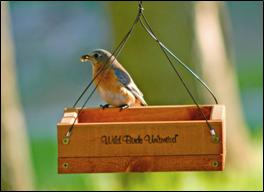 As previously stated, under severe conditions of cold and wet weather, bluebirds can be fed scrambled eggs. They will readily accept them and feed them to their young. Kurt Hagemeister of the Michigan Bluebird Society reports that this tactic saved a nest of young bluebirds several years ago in his yard. The eggs should be cooked as normal, scrambled, let cool, and then put out in a tray type of birdfeeder not far from the nest. If the birds don't eat them within a day or two, remove them from the area so they don't go bad or attract unwanted predators.
As previously stated, under severe conditions of cold and wet weather, bluebirds can be fed scrambled eggs. They will readily accept them and feed them to their young. Kurt Hagemeister of the Michigan Bluebird Society reports that this tactic saved a nest of young bluebirds several years ago in his yard. The eggs should be cooked as normal, scrambled, let cool, and then put out in a tray type of birdfeeder not far from the nest. If the birds don't eat them within a day or two, remove them from the area so they don't go bad or attract unwanted predators.
Suet
Bluebirds will sometimes feed on suet. Since insects are plentiful in the summer, 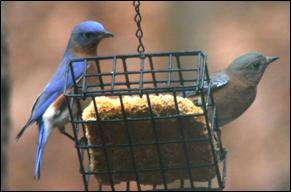 it will be difficult to get them to eat suet at that time of year. But as the weather gets cold and insects are scarce or non-existent, they will really eat up the nutritious and energy-filled suet that you provide for them. Commercially made suet cakes are easy and relatively inexpensive. Cakes with hulled sunflower, peanut bits, raisins, and ground up corn meal are very good.
it will be difficult to get them to eat suet at that time of year. But as the weather gets cold and insects are scarce or non-existent, they will really eat up the nutritious and energy-filled suet that you provide for them. Commercially made suet cakes are easy and relatively inexpensive. Cakes with hulled sunflower, peanut bits, raisins, and ground up corn meal are very good.
Here is a great recipe that you can make to attract bluebirds:
Bluebird Suet Recipe

1 cup lard
1 cup crunchy peanut butter
1/3 cup sugar
1 cup whole wheat flour
2 cups oatmeal
2 cups cornmeal
1 ½ cup raisins
Put raisins in sauce pan and add water to cover. Bring to boil; remove pan from heat and let raisins cool. Drain water and cut raisins in half. Set aside.
In a large mixing bowl, mix together flour, oatmeal and cornmeal.
In small sauce pan on low heat, melt lard, peanut butter and sugar. Pour liquid mixture into dry ingredients and mix well. Add raisins.
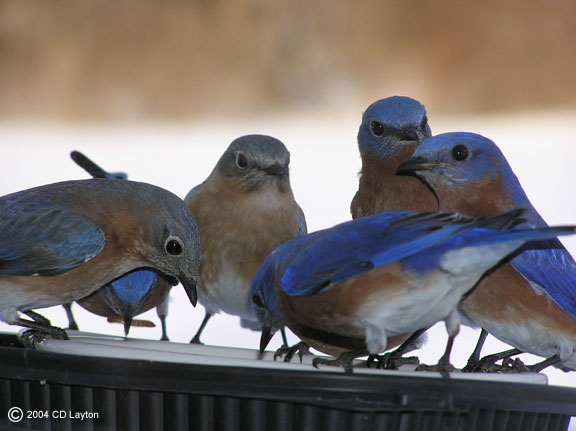 Seed And Other Foods
Seed And Other Foods
During the cold weather months, you can feed Bluebirds sunflower hearts, softened raisins, blueberries, and currants. Note that Bluebirds won't eat these other foods much except during the harshest of conditions. This typically occurs during late Winter or even early Spring, when the weather is still very cold and natural foods are running out. Otherwise, they will continue to eat mostly wild berries and other fruits they can find. It is best to put it in an open tray feeder or a special bluebird feeder which has openings at either end for the Bluebirds to enter.
The Jail Bluebird Feeder
A very good type of feeder is the Bluebird Jail feeder. This feeder (pictured at the right), was designed to exclude larger birds, such as Robins and Starlings, from getting at the mealworms or other food, before the Bluebirds can get it. The feeder is enclosed (which shelters the mealworms/food) with a dish in the middle for the food. The birds can either enter through the 1 1/2" diameter entrance holes on the ends or in between the wooden dowel "bars". Unlike some Bluebird feeders that have Plexiglass instead of the bars, the jail feeder is more open and makes it easier for the birds to get to the food. The trick to getting Bluebirds to start using the feeder is to leave the top open (and even remove the bars) temporarily until the birds "figure out" that there is food in there. Once they start coming regularly, replace the bars and close the top of the feeder. They should start entering through the ends or between the bars.
The Gilbertson Bluebird Feeder
This feeder is another variation of the Jail Feeder shown above. It is also designed mainly to limit the size of birds that can get to the mealworms or other food to Bluebird-sized birds or smaller. So, again, Starlings and Robins will not be able to access the feeding area.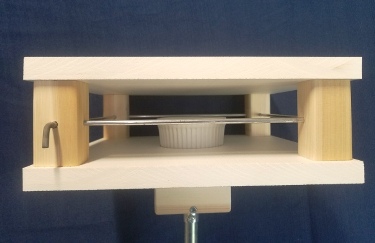
The Gilbertson feeder was designed by Steve Gilbertson of Minnesota. It is a very simple-to-build feeder that almost anyone with basic woodworking skills can make. It is primarily composed of 2x4, 1x10, and 2x2 cedar. There is also some short lengths of 1/8" diameter metal rod which is installed horizontally. This can be found at most hardware stores or home centers.
One of the bars is removable to allow access to the feeding area container. The plan calls for using an old aluminum or tin tuna fish can. You can also buy a small glass dish for this purpose. To download the plans for this feeder design, click below.
Gilbertson Feeder Plans
Bluebirds & Mealworms!
Watch this great video to see how attracted Bluebirds are to mealworms.
Source: https://michiganbluebirds.org/about-bluebirds/feeding-bluebirds
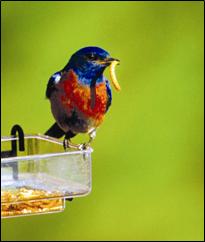
0 Response to "Should I Feed Baby Blue Birds if Patents Left"
Post a Comment